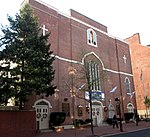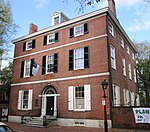Episcopal Diocese of Pennsylvania
1787 establishments in PennsylvaniaAnglican dioceses established in the 18th centuryChristianity in PennsylvaniaDioceses of the Episcopal Church (United States)Episcopal Church in Pennsylvania ... and 4 more
Episcopal bishops of PennsylvaniaEpiscopal churches in PennsylvaniaProvince 3 of the Episcopal Church (United States)Religious organizations established in 1787

The Episcopal Diocese of Pennsylvania is a diocese of the Episcopal Church in the United States of America encompassing the counties of Philadelphia, Montgomery, Bucks, Chester and Delaware in the state of Pennsylvania. The Diocese has 36,641 members in 2020 in 134 congregations. In March 2016, Daniel G. P. Gutierrez was elected Bishop Diocesan; he was consecrated and assumed office on July 16, 2016. Upon becoming bishop in 2016, Gutiérrez implemented a strategy of experimentation and adaptation.
Excerpt from the Wikipedia article Episcopal Diocese of Pennsylvania (License: CC BY-SA 3.0, Authors, Images).Episcopal Diocese of Pennsylvania
Saint James Walk, Philadelphia Center City
Geographical coordinates (GPS) Address Nearby Places Show on map
Geographical coordinates (GPS)
| Latitude | Longitude |
|---|---|
| N 39.94599 ° | E -75.1483 ° |
Address
Old St. Mary's Rectory
Saint James Walk
19016 Philadelphia, Center City
Pennsylvania, United States
Open on Google Maps










